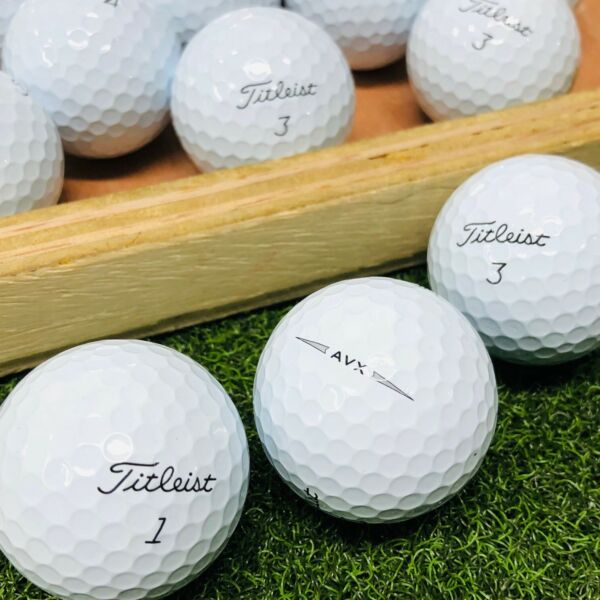Titleist AVX vs Velocity: Are They Similar? Different?
The golf ball market presents players with a plethora of choices, each designed to cater to specific preferences and playing styles.
Among the numerous options, the Titleist AVX and Velocity golf balls have garnered attention for their unique features and performance characteristics.
If you’re reading this, you’re among those who are wondering if they are different and which one might be better.
Fortunately, this comparison will delve into the details of these two golf balls, exploring their construction, feel, distance, and spin performance to assist you in selecting the ideal option that suits your game.
Keep reading…
Titleist Velocity Review

Titleist’s Velocity golf ball is a standout for golfers focusing on distance.
Engineered with a high-speed LSX core and an aerodynamic 350 octahedral dimple pattern, it is built to maximize initial velocity and decrease drag, leading to impressive carry and total distance.
Pros:
- Excellent distance, one of the longest balls on the market.
- A high flight trajectory that is beneficial in carry distance and clearing obstacles.
- The durability is commendable due to the thick NaZ+ cover.
Cons:
- Lacks the soft feel and control around the greens found in higher-end Titleist models.
- Not as much spin, which can limit control on approach shots and around the green.
Titleist AVX Review

Titleist’s AVX golf ball represents the brand’s effort to balance premium performance with a softer feel.
Constructed with a unique GRN41 cast urethane cover and high flex casing layer, it offers exceptional spin control and soft feel while still maintaining impressive distance.
Pros:
- Soft feel caters to golfers who prefer a softer sensation at impact.
- High-performance, low compression core enhances speed and decreases spin for greater distance.
- Excellent spin control on approach shots and around the greens, thanks to the premium urethane cover.
Cons:
- May not deliver the same level of maximum distance as other Titleist balls, such as the Velocity.
- The premium performance comes with a higher price tag, which might not appeal to budget-conscious golfers.
Titleist AVX vs Velocity: How Do They Compare?
Let’s look at some of the distinguishing features of each golf ball to help you decide on the best for your game:
Construction and Design
The Titleist AVX is a three-piece golf ball, featuring a cast urethane cover, a high-flex casing layer, and a low-compression core.
The urethane cover delivers a soft feel and exceptional greenside control, while the high-flex casing layer enhances ball speed and provides greater consistency.
The low-compression core contributes to a softer feel and reduced spin, resulting in increased distance and a more penetrating ball flight.
In contrast, the Titleist Velocity is a two-piece golf ball, incorporating a high-speed LSX core and a thin, NaZ+ cover.
The LSX core is designed to produce faster ball speeds, while the NaZ+ cover promotes low spin and exceptional durability. The Velocity’s focus is on delivering maximum distance and a high, straight trajectory.
Feel and Sound
The Titleist AVX offers a soft, responsive feel due to its cast urethane cover and low-compression core. Golfers who prioritize a premium feel and greenside control will likely find the AVX appealing.
The softness of the ball allows for improved touch on finesse shots and delicate chips around the green.
On the other hand, the Titleist Velocity provides a firmer feel, owing to its high-speed LSX core and NaZ+ cover.
Golfers who prefer a more solid impact sensation and seek maximum distance may find the Velocity’s firmer feel more to their liking.
The Velocity’s sound at impact is noticeably louder than the AVX, reflecting the ball’s focus on distance and speed.
Distance and Trajectory
The Titleist AVX is designed to deliver exceptional distance through its low-compression core and high-flex casing layer.
The core’s low compression promotes efficient energy transfer and reduced spin, which contributes to a more penetrating ball flight and increased carry distance.
So, if you want a lower, more piercing trajectory and impressive distance, you will appreciate the AVX’s performance.
However, the Titleist Velocity is engineered to optimize distance through its high-speed LSX core and thin NaZ+ cover.
The Velocity’s core generates faster ball speeds, while the cover promotes low spin off the tee.
As a result, the Velocity produces a high, straight trajectory with maximum carry distance, which can only be appealing if you prioritize distance above all else.
Spin and Greenside Control
The Titleist AVX’s urethane cover and low-compression core combine to provide exceptional greenside control.
The soft cover enhances spin on short game shots, enabling golfers to execute precise approach shots and control chips around the green.
The AVX’s reduced spin off the tee, combined with the increased spin around the greens, makes it an attractive option for players seeking a balanced performance profile.
In contrast, the Titleist Velocity is designed primarily for distance, and as such, it does not deliver the same level of greenside control as the AVX.
The Velocity’s NaZ+ cover promotes lower spin, which contributes to its impressive distance off the tee. However, this also means that Velocity’s greenside control and spin are less pronounced compared to the AVX.
Conclusion: Titleist AVX or Velocity?

In summary, both the Titleist AVX and Velocity golf balls offer distinct advantages that cater to the diverse preferences and playing styles of golfers.
The AVX’s three-piece construction, soft feel, and exceptional greenside control make it an ideal choice for players who value a premium feel and precise control around the green.
The low spin off the tee and penetrating ball flight further enhance the AVX’s appeal for those seeking a balanced performance profile.
Conversely, the Titleist Velocity’s two-piece construction, firmer feel, and emphasis on distance make it a suitable option for golfers who prioritize maximum carry and a high, straight trajectory.
While the Velocity may not provide the same level of greenside control as the AVX, it excels in generating faster ball speeds and impressive distance.
Related Post:
- Ventus Velocore vs. Non-Velocore: Which Is Better?
- Sub 70 699 vs P790: Which is Better?
- Are Ping Eye 2 Irons Still Good?

Want to Get Better at Golf?
Get "Ben Hogan's Five Lessons" and join thousands of others improving their golf skills.
Learn the Fundamentals: Stance and Posture > Golf Grip > The Swing.
This book has LOADS of positive reviews. THOUSANDS OF REVIEWS. A MILLION COPY SOLD. CHEAP!
Get the Book Here
